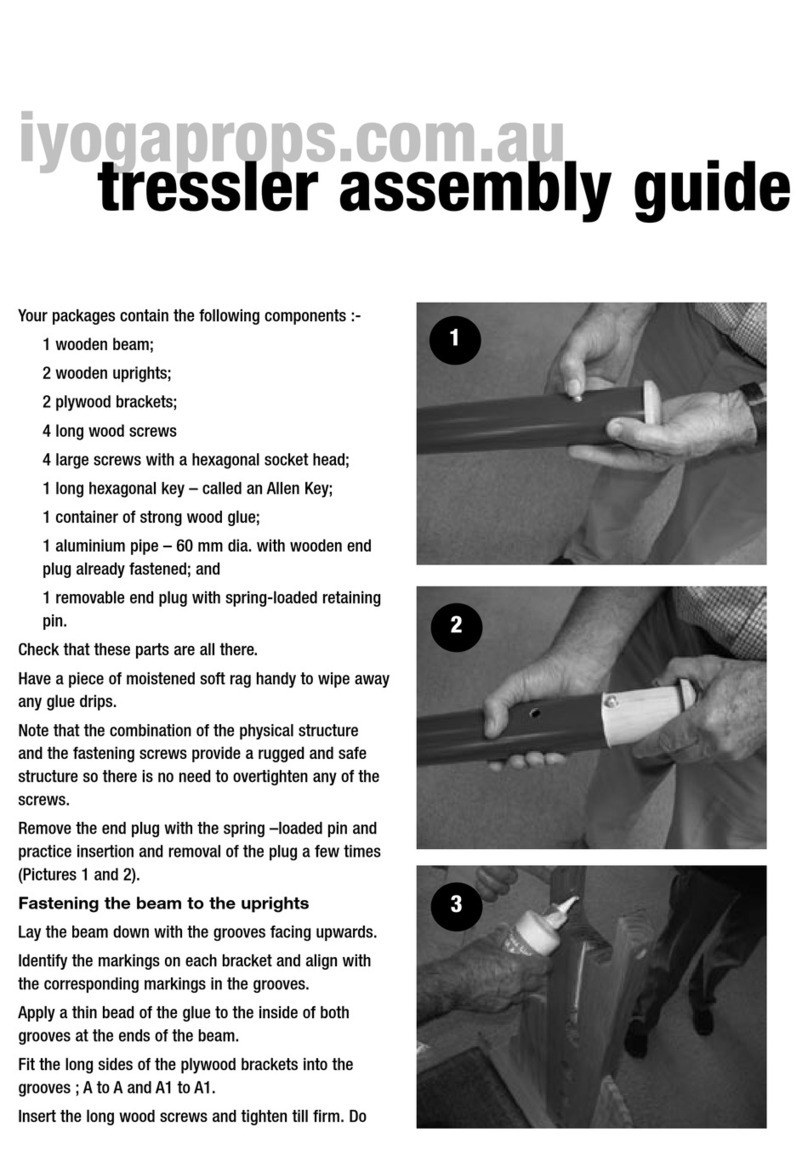
gently stretch it longer, then fold
(Figure 3).
The upper and lower sections can only
be disassembled and reassembled in
the folded form (Figure 4).
Removal and replacement of the
kapotasana extension from its storage
position in the upper section of the
bench (Figure 5) should only been
done with the big diameter bars at the
top. The kapotasana extension will
simply fall out if the bench is
held upside down.
To remove the foot bar, simply twist
and lift out (Figure 6).
Care
The FAB is supplied with a durable
laquer finish. Keepout of bright sun
and weather.
Safe use
• Read these instructions carefully
• At all times:
• avoid any use which causes undue
pressure or pain in any part of
the spine or neck, especially the
lumbar spine (the lower section of
the spine between the rib cage and
the pelvis).
• never sit upright from the FAB;
always slide onto the floor and
roll onto your side before sitting
up except when practicing
Kapotasana.
• We strongly recommend that before
using the FAB, especially in the
case of spinal injury, that you seek
the instruction and advice of a
qualified Iyengar Yoga teacher. To
find your nearest teacher go to www.
bksiyengar.com. In the case of injury
you should seek medical advice.
Intelligent practice of back bends can
be very beneficial to the health of the
spine, but must be approached with
caution. The teaching of Iyengar yoga
emphasises this cautious approach.
Particular care is given in back bends
to the state of the lumbar spine and
neck.
Viparita Dandasana
The principle pose for which the
Iyengar back bender was designed
is Viparita Dandasana (Figure 12 and
top of page 1). The safe practice of
this pose is described here. These
principles can be applied to the other
poses.
1 Lay a blanket on the FAB (optional).
2 Sit on the FAB close to the bottom
end (Figure 7).
3 Lay back and observe the sensation
in your spine. If uncomfortable move
even closer to the bottom of the FAB
so that your spine including your
neck becomes relatively flat (Fig 8).
4 If this position feels comfortable and
you are able to extend your spine
(arch your back) further then use your
feet and legs to push yourself higher
onto the bench. It may be necessary
to support your head with a cushion
(Figure 9) when your neck is near
the top of the bench to avoid over
extending the neck (Figure 10).
5 If the spine still feels comfortable
you can continue to move further
over the bench until your head nears
or touches the floor (Figure 11).
6 When well over the bench you can
grasp your elbows above your head
(Figure 12). If this induces pain,
support the elbows and/or head
(Figure 13) or clasp the hands over
the abdomen (Figure 11).
7 You may use a strap around the
thighs to prevent the legs from rolling
out (Figure 14).
8 Depending on your height and how
far over the bench you are able to go,
you may be able to press your feet
into the foot bar (Figure 12). Taller
people may find it more comfortable
to remove the foot bar. (Figure 15)
9 Beginners should stay for only a
short time (up to 2 minutes) but with
practice you may stay for longer
periods, provided that no pain is
experienced.
Dismounting from the FAB
10 Do not sit up from the back bend
position.
11 Those whose shoulders are on
the foot side of the top (Figure 9)
can simply slide down toward the
feet, pause for several breaths before
using the arms to carefully sit up
(Figure 16).
Those who are well over the bench
(Figure 12) can dismount by sliding
down onto the floor and resting for
several breaths before rolling onto the
side and carefully sitting up (Figure 17).
Other techniques for
minimising discomfort
With practice, those who are
susceptible to lower back discomfort
may be able to move a little deeper
over the bench by supporting the
knees with a bolster or firm cushion .
Alternatively you may practice using
the half bench (Figure 23).
3
6
4
✗
2
✓
5






















